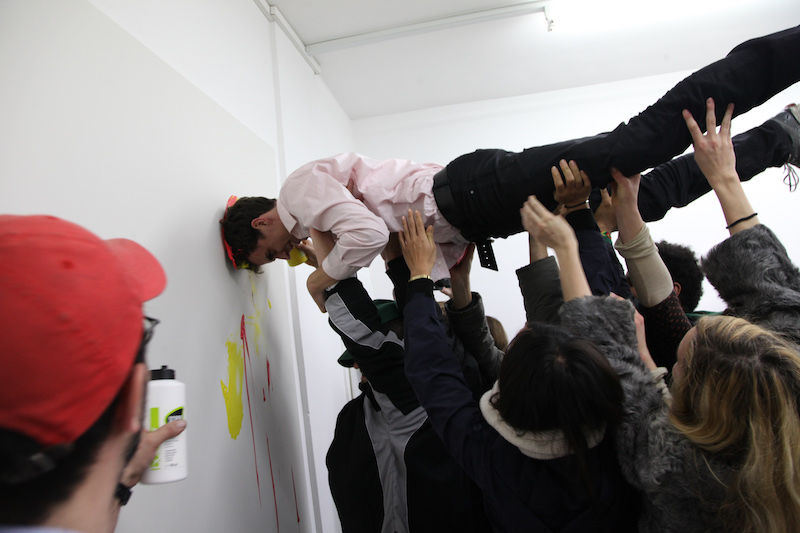 "Exiting Things", performance, video, acrylic paint on canvas, COCO, Vienna, 2010 © Christian Falsnaes, courtesy of PSM, Berlin
"Exiting Things", performance, video, acrylic paint on canvas, COCO, Vienna, 2010 © Christian Falsnaes, courtesy of PSM, Berlin
It is both fascinating and terrifying to participate in a performance by Christian Falsnaes: the 1980-born Danish artist commands exhibition visitors to follow his demands. They ought to dance, to hug, to scream, or even to paint his paintings. And, quite surprisingly, no matter how much they expose themselves and no matter if they actually enjoy doing as they are being told, people usually follow his order. Using the spectators as his artistic material and manipulating group dynamics with painstakingly planned scripts, Falsnaes' enthusiastic and insisting persuasion moves crowds who seem to willingly follow his authority. Performative elements are, however, only one aspect of his practice, which also includes collages, drawings, sculpture and painting, which Falsnaes originally studied in Vienna. Having just moved from Berlin to New York, we spoke about his studio practice, the authorship of his works and his general desire for utterly human gestures.
Anna-Lena Werner: The first time I saw your work was at Galerie DREI in Cologne. There were abstract paintings hanging in the gallery space. Unfortunately I missed the performance...
Christian Falsnaes: ...You say you missed it, as if you were missing the central part of the exhibition. But it was, in its core, a painting exhibition.
ALW: This is how you see it?
CF: Yes, this is quite important for me not only regarding that exhibition, but my works in general. Whether they are sculptures, paintings or drawings, I don't see my works as leftovers from performances. It's even the reverse. In this particular series of paintings, which is called "ONE", I see the performance as the production circumstance for the work. I use the context of a performance to produce the paintings. The paintings are the main work.
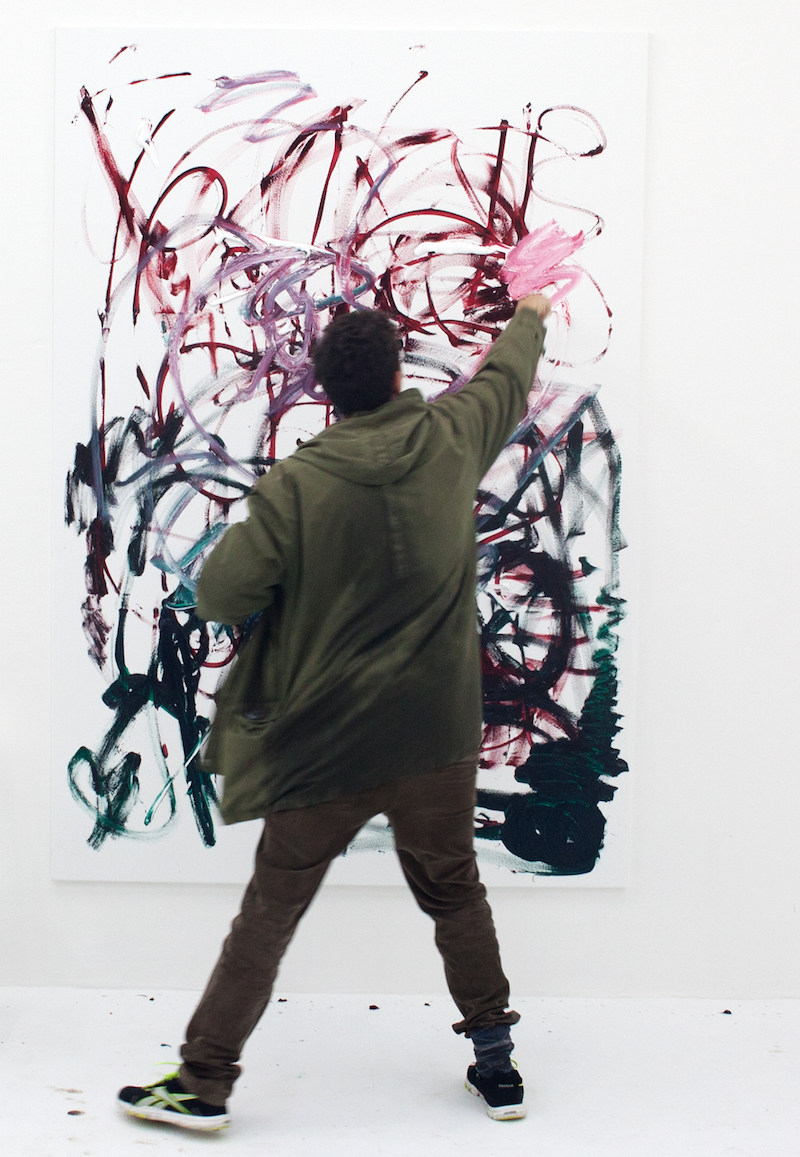
"ONE" (2013) © Christian Falsnaes, courtesy of PSM, Berlin
ALW: For the paintings it doesn't matter whether you produce them yourself, or whether somebody else produces them with your guidance?
CF: In this case it matters very much, because the series "ONE" is always painted by random exhibition visitors. Furthermore, each painting is made by a collective and not by an individual. I am interested in abstract expressionism and the idea of gesture and expression: that through dance or painting people can express something fundamentally human. The history of abstract expressionism is so closely linked to the handwriting of the artist, but what I try to do with this work is to change the position of the artist with the viewer.
ALW: Is there something like a signature gesture from you?
CF: In these works, my artistic handwriting or my signature is the way I control the situation in which they are created.
ALW: How much is your artistic signature part of the "ONE" paintings?
CF: For "ONE" the instruction is not only a concept, but also as an artistic challenge. If you give random people a brush and tell them to paint what they want, 80% would write their name or draw a smiley or a flower. My challenge is to create a situation in which the person I work with actually paints something that can be seen as an expression of something fundamentally human, an artistic urge. Therefore I need to push them to a point where they move out of their comfort zone and beyond their first instinct of painting something they feel secure about. I also need to control the process in a way that the painting ends up as something I find interesting.
ALW: How is your relation to such an object that you have a collective make for you? Does it feel to you like the objects are yours?
CF: I definitely feel like they are mine, because this is my artistic method. When you engage in the material of art forms like painting or sculpture there is always something uncontrollable that has to do with the material itself. The work is never only the result of a concept. The question is: how much space for that uncertainty do you leave in your work? The challenge for me is to create a script for the production of a work, open enough for the ideas and inputs of participants, but still defined enough for me to able to control it. I delegate parts of my studio practice to the public. That's why I still see them as my pieces.
ALW: And yet they are not merely following your instructions, because you want them to create a gesture that is actually their own...
CF: ...Exactly, otherwise I could just hire assistants. It's both terrifying and exciting to work like this: Not being able to control everything, this play between control and freedom, feeds so much content into my work. I sometimes have to think about music: If everyone would play exactly the same tones in exactly the same way then you can just make a midi version of the song. If everyone would play whatever tones come into his or her mind without an overlying structure it would be pure cacophony. But if you have a collective structure that everybody can improvise within, then it can become interesting.
ALW: Is that how you describe your own approach to the situations you create?
CF: Yes. I always wonder when someone asks me if I am just improvising my performances. I actually have a carefully planned out script. Everything is planned beforehand, and that allows me to be present in the moment and react to the individual reactions of the visitors according to structure of my script.
ALW: How do these scripts look like?
CF: When I hire performers to give instructions, I have to give my scripts a form that is readable to others. It's mainly a description of a succession of situations, but it also contains instructions on how to address the crowd, such as friendly, authoritarian, or aggressive as well as the body language and words that should be used. The script has to be defined enough to let the instructor know exactly what they should make people do, but at the same time open enough to deal with an infinite number of varying circumstances. Depending on how many people show up for example - 50 or 500 or 5000 - the situation can change a lot. That's why the structure needs to be defined. You need to know what your goal is.

"Available", mobil phone, visitors, Kunstverein Braunschweig, 2015 © Christian Falsnaes, courtesy of PSM, Berlin
ALW: How do you define a successful performance?
CF: It's very difficult to put that into a formula. I see it and have a feeling about it. I have the urge to see things being carried out the way I imagined them. But even mistakes can be good. I am interested in HOW people behave.
ALW: You seem very self-confident when you perform. Is it a mask that you are able to protect yourself with?
CF: My demeanor is not putting on a mask, but rather a matter of behaving according to a specific situation. What you describe as self-confident relates to the function of leadership. The person conducting the performance is the leader of that constructed situation. This person needs to act self-confident because she or he is the only one who knows what is going to happen. That's why the script makes this person so powerful – whether it's me or somebody I hire to perform the work as an instructor. The best way to make people do what you want is to behave as if it is the most natural thing in the world for them to do.

 "Front", performance, spray painted OSB-plates on wood structure, Bielefelder Kuntsverein, 2014
"Front", performance, spray painted OSB-plates on wood structure, Bielefelder Kuntsverein, 2014
© Christian Falsnaes, courtesy of PSM, Berlin
ALW: Kareth Schaffer did your piece "FRONT" at KIOSK in Ghent. She screamed the same way that you do. Why do you scream so much?
CF: That has to do with techniques of conveying information. Loud and energetic behaviour can be used to display and convey enthusiasm, but it also has a practical reason. Shouting can be a way to make everyone hear you, especially when you're addressing a large crowd without a microphone, as Kareth did in Ghent. My works are often about delegating the artistic expression to the audience, but in these cases I also need to delegate the delegating itself.
ALW: It sounds like political work. You develop a strategy and then you pass decisions on to ministers and congressmen.
CF: There is a rich history of delegation in art. It's a concept that I am interested in.
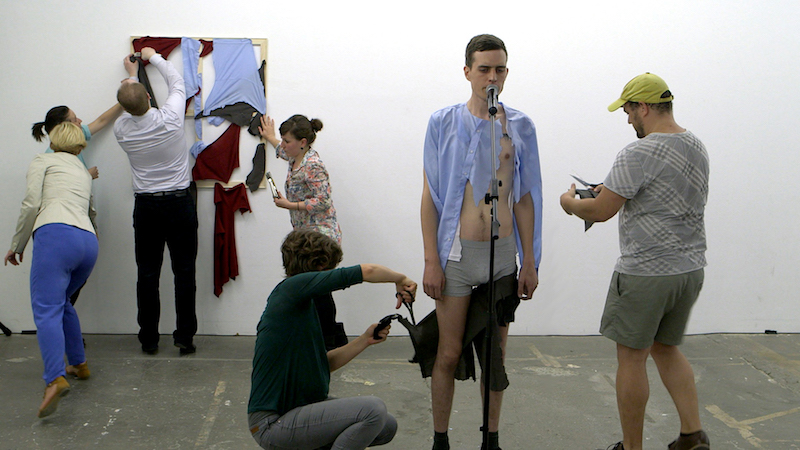 "Opening", performance, cut clothes on stretcher bars, video, KW Institute for Contemporary Art, Berlin, 2013 © Christian Falsnaes, courtesy of PSM, Berlin
"Opening", performance, cut clothes on stretcher bars, video, KW Institute for Contemporary Art, Berlin, 2013 © Christian Falsnaes, courtesy of PSM, Berlin
ALW: I had to think about two books when I first saw your work. The one is the "Mass Ornament" by Siegfried Kracauer and the other one is "Psychology of Crowds" by Gustave LeBon. Both of these books deal with the notion of leadership and how masses are being formed, controlled and manipulated into the agenda of the leader. With this in mind, I think there are two ways to look at your performative work: One is the expression and the letting out of fundamentally human gestures. But the other one is the shocking realisation how easy it seems to control people and make them do what you like.
CF: That is a theme that I am very interested in and have explored extensively. But the end goal of the manipulation in my work is not ideology but art. That's very important for me. I also believe that this is part of the reason why so many people willingly participate, because they all know that we are doing art. My works don't have any goal outside of themselves. They don't exist to prove a point beyond the experience within them. The art context, the museum, the exhibition, allows a self-reflection that I believe has a great potential. It facilitates an analytical and somewhat distant view on everything that is viewed within it. The emotions that occur are real, but everyone knows that they occur within a very specific context.
ALW: Are you ever surprised how much people cross their own borders?
CF: Very often. But I have so much experience now that I kind of have an idea about how people will react. At the same time it never gets boring for me to see people's reactions. Although this might sound a bit romantic, I think that every human being has something beautiful and artistically exciting. That's a part of what I want to provoke, making the viewer reveal something human.

"Thousand Faces", single-channel audio on audioguide system, visitors, Danish National Gallery, Copenhagen, 2016 © Christian Falsnaes, courtesy of PSM, Berlin
CF: I prefer when people invest a part of themselves into the work. But I have experienced many times that people flat out reject even the idea that they should participate. That's also a reaction though, and it's their contribution to the work in that moment, so I accept that as well. In the end it's a matter of individual decision.
ALW: Do you know more about people through the performances you do?
CF: I don't think I know more about people in general, but I know more about people in a very specific situation. I know a lot about people's reactions in constructed situations in museums for example.

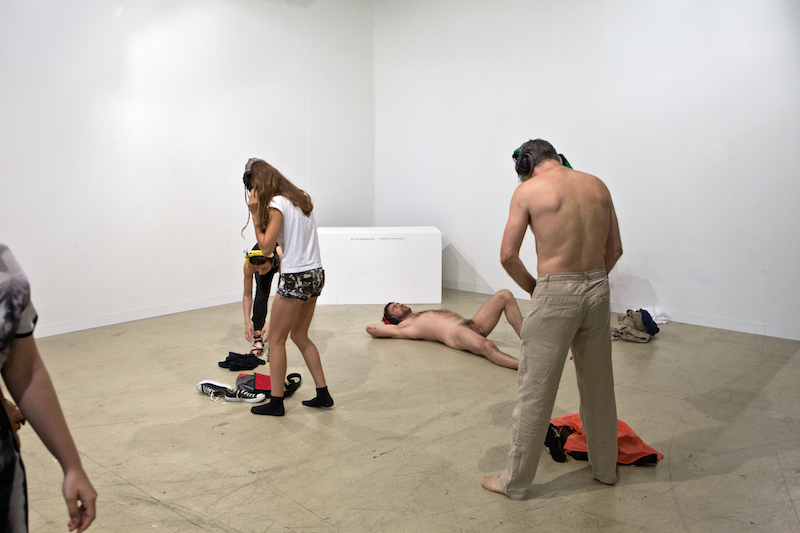
"Justified Beliefs", audio on headphones, two people hired to follow instructions, visitors, Art Basel Statements with PSM, 2014 © Christian Falsnaes, courtesy of PSM, Berlin
ALW: People put emotions and curiosity into the situations you create, but what role does physical intimacy play?
CF: I look for something human – for expression and articulation, and that also includes the body. Dance, physical contact and bodies relating to each other can facilitate experiences that you cannot convey through words or images. These moments - when people kiss or look each other in the eyes for example – can create strong emotional reactions. Within the context of an artwork, however, it is possible to reflect upon that reaction at the same time. I am also interested in group dynamics and social interaction. If two people are asked to touch each other for example, how do they negotiate what kind of touching to engage in? Usually these decisions are made within a fraction of a second and relate to invisible social structures that I try to manipulate. At the same time, I think physical intimacy is a fundamental part of viewing art. Why do we travel to a museum to see a sculpture or a painting in real life? The physical object is a body that we want to be close to. In at time where so much of our communication is digital, I think there is a craving for physical intimacy that art can respond to.
ALW: Do you write down what kind of reactions and instincts you want to trigger?
CF: Yes, that's a part of my script. It's a bit like a choreography, but based on social interaction more than precisely defined movements.
ALW: Although you say that you don't put on a mask: How much do you allow your own personal feelings and instincts to emerge when you encounter audiences?
CF: It's an interesting question because it relates to the concept of identity. You don't always react in the same way. You behave differently when you do an interview with me than when you are home alone with your boyfriend, you behave differently when you give a speech in front of 50 people or when you take a Yoga class. Are these different roles? I guess they are. This "role" of conducting a performance is just one specific way of relating to a situation among many others. The difference is that I am constructing the rules for that situation, whereas in most social interactions I submit myself to whatever format I am interacting within. That is a beautiful thing about art: As an artist I can create a world, in which I define all the rules.
I think a part of my deep urge to do this kind of work is that I always had a lot of problems with authority that led to a lot of struggles and confrontations. In my work, I kind of have created a space that allows myself and others to look at, react to and deal with a hierarchical structure.
ALW: Do people react better to the authoritarian and strict tone, or do they react better to a polite and friendly one?
CF: That depends how you define "better". It depends what you want from people, and how many people you want something from. When you work with five people you can take your time and explain every detail, you can look every person in the eye and tell them that you you'd like them to do something. When you have 50 people you have to display much more certainty in order to move the crowd. If you want a lot of people to move within a short time the easiest way is to give them orders. There is a reason why military tactics have evolved they way they have. They have been created out of the need to move huge amounts of people as quickly and effortlessly as possible. In that case it's not possible to work with friendly persuasion.
ALW: Are you sometimes shocked about the fact that this is how we people function?
CF: Yes. That's why I think it's so important to look at and deal with these dynamics, to allow the emotions and even to be disgusted or angry. I don't know where else to work with this, other than in art.
ALW: You studied philosophy for two years. Did that have any impact on your practice?
CF: Probably. Definitely. I am a very rational and logical person. Even if it may not look like that at first glance, I think most of my works have a quite logical structure and approach.
ALW: Is your practice asking for rationality?
CF: Yes, I think so. It's a balance between controlled rationality and uncontrollable emotion.
ALW: Have you ever taken acting classes?
CF: No, I have never been interested in acting or theatre. I started as a painter and my practice has developed much more from looking at art and art history, rather than at performing arts and theatre. A lot of my work is a response to the tradition of performance art.
ALW: Such as?
CF: Like the role of the artist, the body, and identity. I have tried to replace the performing body of the artist with the performing body of the viewer. The material is not my body and my identity, but the body and identity of the exhibition visitor. This replacement also relates to the current shift in society, the consumer now being a "prosumer", always in control of what and when he or she consumes, like in social media compared to TV. I think the museum is the ideal place to investigate that shift, because of the freedom to move around as you want and take your own decisions, as opposed to the theatre, where everybody needs to come at a specific time, for a specific time period.
ALW: Are there also disadvantages in working with exhibition visitors?
CF: There are limitations. Exhibition visitors hardly ever spend more time than two hours in any of my pieces. There is a limit to how much artistic progression you can do within two hours, a day, or even a week. Therefore I have recently started to do more studio practice, making paintings and collage works myself in my studio, because it allows me to work with a process that can take half a year or longer. Although I find it interesting to delegate gestures and authorship, I also discover that there are things I cannot delegate.
ALW: Do you consider yourself a painter?
CF: I definitely consider myself a painter, but I am not only a painter. I don't like it when people call me a performance artist either. The core of my work is not a specific media, but an underlying approach. Painting has always been an integrated part of my practice though, and now that I am in New York, in a new studio, I feel inspired to rethink what I am doing and for example produce new studio based collage works.
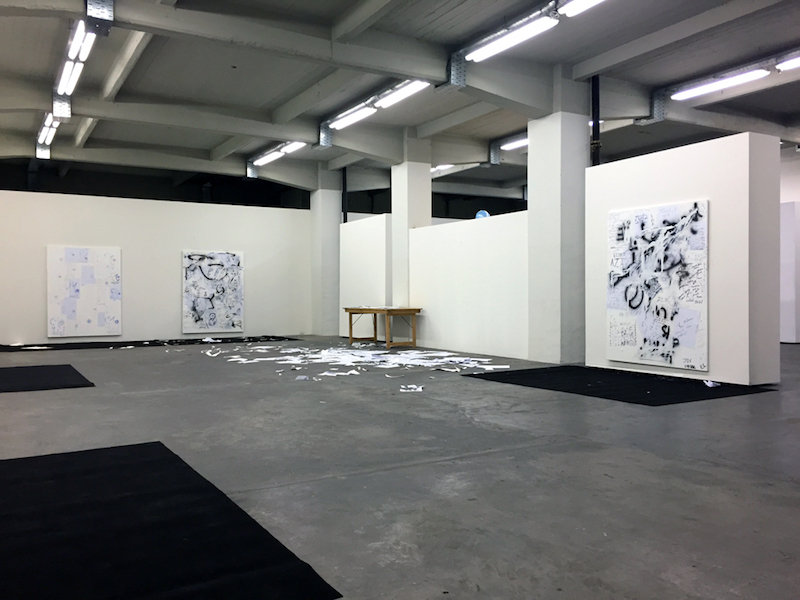
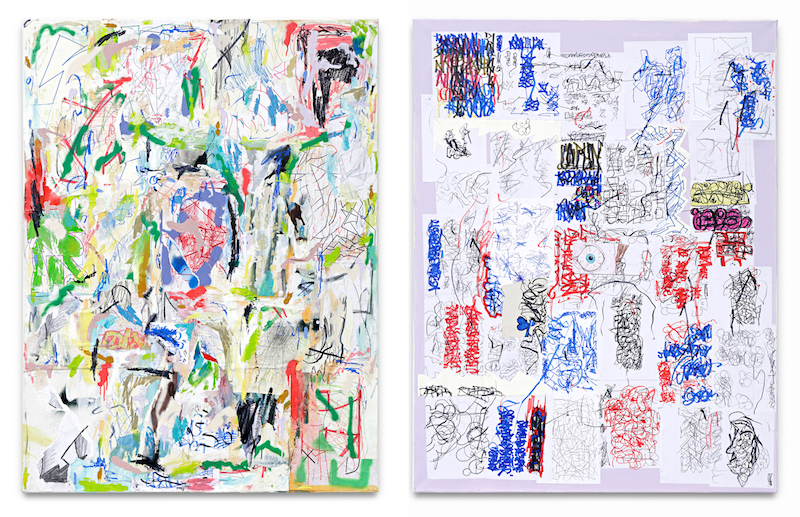
Above: "Many", installation view, Juan and Patricia Vergez collection, Buenos Aires, 2015 ; Below: "Touch" (2016) and "All Of Us" (2016) all © Christian Falsnaes, courtesy of PSM, Berlin
ALW: What are the collages that you currently produce about?
CF: I constantly generate material, such as drawings, paintings and material that is generated in performances, collective processes etc. over long periods of time. I re-use this material, cut it up, re-work it and put it into a new form that I continuously change and re-work until it get's a certain density. It's very much about these ideas of gesture, corporeality, the physical presence of the painting as an object, the physical reaction, the feeling of intimacy with the object etc. It's layered and fragmented and also deal with information overload. With these works I can work on a long process that is not defined beforehand. I can let my interaction with the material form the decisions I make and in many ways deal with things that are impossible within my performance works.
falsnaes.com
Upcoming exhibitions:
February 25 – April 16, 2017
Future Generation Art Prize
Pinchuk Art Centre, Kiev
futuregenerationartprize.org
May 21 - September 3, 2017
Duett mit Künstler_in. Partizipation als künstlerisches Prinzip
Museum Morsbroich, Leverkusen
museum-morsbroich.de
May 13 - June 4, 2017
Bienal de Performance, Buenos Aires
bienalbp.org
May 24 - 27, 2017
Solo presentation with PSM at ArteBa, Buenos Aires
arteba.org
May 20 – August 6, 2017
DEJIMA - CONCEPTS OF IN- AND EXCLUSION
Gesellschaft für Aktuelle Kunst, Bremen
gak-bremen.de
June 17 – July 16, 2017
Conditions of Political Choreography
n.b.k., Berlin
nbk.org
